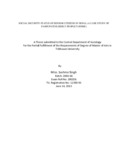Please use this identifier to cite or link to this item:
https://elibrary.tucl.edu.np/handle/123456789/2701| Title: | Social Security Status of Seniior Citizens in Nepal (A Case Study of pashupati Elderly People’s Home) |
| Authors: | Singh, Sushma |
| Keywords: | socio-economic;senior citizens;psychological |
| Issue Date: | 2013 |
| Publisher: | Department of Sociology |
| Abstract: | Ageing has now become a big problem with unprecedented increase in the number ofelderly people worldwide. Number of persons aged 60 years or over There areapproximately 810 million persons aged 60 years or over in the world in 2012 and thisnumber is projected to grow to more than 2 billion by 2050. At that point, older personswill outnumber the population of children (0-14 years) for the first time in human history.Asia has more than half (55 per cent) of the world’s older persons, followed by Europe,which accounts for 21 per cent of the total. According to the 2001 census, Nepal’s elderly population constitutes 6.5 percent of thetotal population of the country. During the years 1991-2001, the annual elderlypopulation growth rate was 3.39 percent as against the national population growth rateof 2.3%. According to the 2011 census, the percentage of elderly population hasincreased to 9.1 percent (male 4.6 % and female 4.5%). wwwwww.nepalnews.com/.../18567-nepals-ageing-population-are-we-prepare) The elderly population is estimated to double by 2017. Elderly people in Nepal areusually found active and productive in their advancing years . they are involved inchildcare, cattle herding, handicraft making and other farming related activities.Elderly females, in particular, mostly share responsibilities in household chores.However, their contribution and economic value have not been duly recognised.Making an overall assessment of the living conditions of the elderly people staying at thePEPH was the general objective of the study. Assessing the challenges of senior citizensat PEPH; identifying thereasons for the displacement of a large number of old-agedpeople from their homes and making recommendations to the concerned authoritiesregarding the urgent steps to be taken for helping the old-aged people were the specificobjective of this study. Of the total population, only 60 people were selected as the respondents in this study. Therespondents were selected on the basis of simple random sampling method, while thepopulation was purposively selected. Questionnaire was the major tool of collecting data.Apart from this, Participatory Rural Appraisal (PRA) and Rapid Rural Appraisal (RRA)were also used for collecting more reliable data from the field survey. It was found that majority of the respondents did not have own home.But they werefound to have left their homes due to conflict and lack of harmony with their familymembers. Some of them had lost their homes due to natural disasters. Lack ofpersons tooffer them food and necessary care, loss of income, domination by their family members,physical disabilities were the major reasons behind choosing PEPH as their shelter.Majority of the respondents were found satisfied with the services being provided to themat the PEPH. Speaking on thegroundof the food served at the PEPH,65%stated that thefood was reasonable. Majority of the respondents said that whatever clothes being givento them were sufficient and satisfactory. Similarly, while assessing the consideration ofthe voices of elderly people at PEPH, about 70 percent stated their voices wereconsidered. Speaking on the satisfactionlevel of the respondents on the medical facilitiesoffered to them, about 80 percent of the respondents were happy with the medicalfacilities being provided at the elderly home. Most of them complained of rheumatism,asthma and loss of appetite. About61.7percent pointed out the need for making overallimprovements in the facilities and services being offered to the people at the shelterhome. Majority of the respondentshad childrenandabout45percent of the respondentsconceded the fact thatwerechildless.Speaking on the habit of smoking, majority of therespondents said that they were smokers. About18.3 percent of them said that they quitsmoking after it had a negative impact in their health. To sum up, the social security status of the elderly people at PEPH was found to besatisfactory. However, there are some challenges and problems that need to be addressedin due course of time for the welfare of the elderly people living at PEPH. |
| URI: | http://elibrary.tucl.edu.np/handle/123456789/2701 |
| Appears in Collections: | Sociology |
Files in This Item:
| File | Description | Size | Format | |
|---|---|---|---|---|
| COVER.pdf | 50.44 kB | Adobe PDF |  View/Open | |
| CHAPTER.pdf | 219.03 kB | Adobe PDF |  View/Open |
Items in DSpace are protected by copyright, with all rights reserved, unless otherwise indicated.
